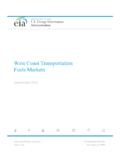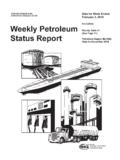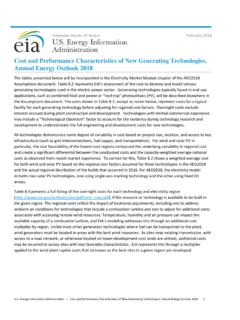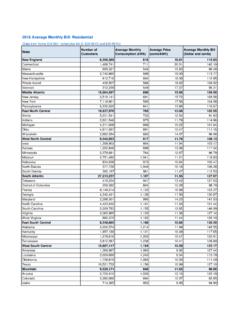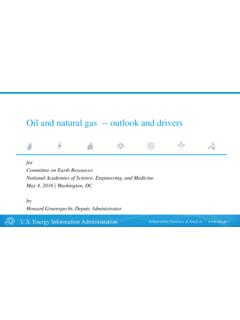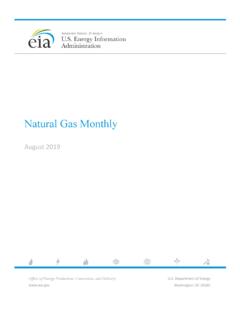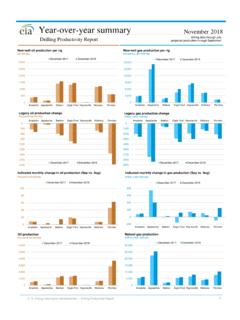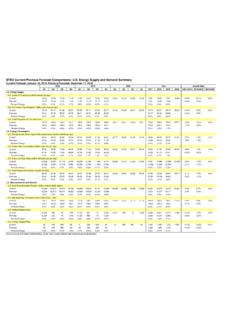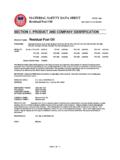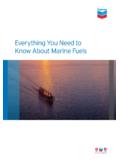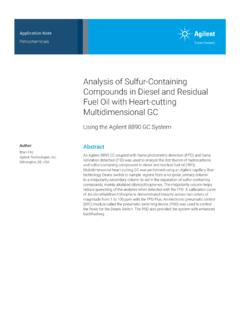Transcription of The Effects of Changes to Marine Fuel Sulfur Limits in ...
1 The Effects of Changes to Marine fuel Sulfur Limits in 2020 on Energy Markets March 2019 Independent Statistics & Analysis Department of Energy Washington, DC 20585 Energy Information Administration | The Effects of Changes to Marine fuel Sulfur Limits in 2020 on Energy Markets i This report was prepared by the Energy Information Administration (EIA), the statistical and analytical agency within the Department of Energy. By law, EIA s data, analyses, and forecasts are independent of approval by any other officer or employee of the United States Government. The views in this report therefore should not be construed as representing those of the Department of Energy or other federal agencies. Energy Information Administration | The Effects of Changes to Marine fuel Sulfur Limits in 2020 on Energy Markets ii Table of Contents Introduction.
2 1 Section I: Forecasts and projections of IMO Effects .. 2 Demand for Marine fuels .. 2 Refining margins .. 4 Refinery operations and production .. 6 Trade and crude oil spreads .. 7 Section II: Uncertainties of IMO projections .. 9 Uncertainties for both refiners and shippers .. 10 New fuel specifications: .. 10 LSFO/HSFO spreads: .. 11 Future policy uncertainty: .. 11 fuel availability: .. 11 Uncertainties mainly for 12 Scrubber uptake: .. 12 Switch to alternative fuels: .. 12 Compliance/enforcement: .. 13 Slow steaming: .. 13 Uncertainties mainly for refineries .. 13 Downstream unit investments: .. 13 Planned refinery capacity (new/expanded): .. 14 Energy Information Administration | The Effects of Changes to Marine fuel Sulfur Limits in 2020 on Energy Markets iii Figures Figure 1: Marine fuel Sulfur Limits .. 1 Figure 2: International Marine shipping consumption by ocean-going vessel bunkering at ports.
3 3 Figure 3: refinery margins .. 5 Figure 4: Projected diesel, gasoline, and jet fuel crack spreads .. 6 Figure 5: Crude oil and residual oil processing .. 7 Figure 6: diesel, residual fuel , and unfinished oils trade .. 8 Figure 7: IMO projection uncertainties across stakeholders .. 10 Figure 8: Shipping industry compliance pathways .. 12 March 2019 Energy Information Administration | The Effects of Changes to Marine fuel Sulfur Limits in 2020 on Energy Markets 1 Introduction With a planned effective date of January 1, 2020, the International Maritime Organization s (IMO) new regulations (IMO 2020) limit the Sulfur content in Marine fuels that ocean-going vessels us e to by weight, a reduction from the previous limit of established in 2012. The IMO adopted the plan for this policy change in 2008, and in 2016 reaffirmed an implementation date of 2020. The change in Sulfur Limits has wide-ranging repercussions for the global refining and shipping industries as well for petroleum supply, demand, trade flows, and prices.
4 The shipping and refining industries have already begun making preparations and investments to varying degrees to accommodate IMO 2020 regulations. As the implementation date for the Sulfur cap approaches, the Energy Information Administration (EIA) expects that shifts in petroleum product pricing may begin as early as mid-to-late 2019. EIA anticipates that the Effects on petroleum prices will be most acute in 2020, and the Effects on prices will be moderate after that. However, the regulations will affect petroleum supply, demand, and trade flows on a more long-term basis. Figure 1. Marine fuel Sulfur Limits EIA shows the Effects of these new regulations in both the Short-Term Energy Outlook (STEO), published monthly, and the Annual Energy Outlook 2019 (AEO2019), released in January 2019. Because IMO 2020 will affect petroleum markets across several years, EIA s STEO forecast and AEO2019 projections provide complementary insights into the Effects of the regulations.
5 Both STEO and AEO2019 are based on current laws and regulations. AEO2019 centers around a Reference case based on relationships and general equilibrium models that satisfy projected energy demand under a set of constraints. March 2019 Energy Information Administration | The Effects of Changes to Marine fuel Sulfur Limits in 2020 on Energy Markets 2 STEO provides forecasted data that are updated every month. EIA uses a combination of econometric models based on historical data to forecast where EIA anticipates energy markets will move in the next two years. The STEO relies on historical data, short-term trends, and analyst judgment in creating this forecast. Although the STEO forecasts fewer variables than the Annual Energy Outlook, STEO s publication frequency allows EIA to incorporate developments related to the IMO rule more regularly than AEO2019, which projects variables at an annual frequency through the year 2050.
6 In addition, because the STEO is published monthly, EIA adjust its forecasts continuously to incorporate new information. Because the current STEO forecasts end in December 2020, the data in AEO2019 provide EIA s projections with insight into how IMO 2020 will affect petroleum markets beyond 2020. In addition, AEO2019 has more detailed data on refinery operations, Marine fuel use, and fuel costs than the STEO. Projections in the Annual Energy Outlook are generated from EIA s highly detailed, structured equilibrium models in its National Energy Modeling System. The first section of this report explains the findings related to IMO 2020 from the STEO and AEO2019 analysis. The second section discusses the uncertainties that might affect the way that actual outcomes deviate from EIA s forecasts and projections. Section I: Forecasts and projections of IMO Effects Demand for Marine fuels Globally, Marine vessels are a critical part of the global economy, moving more than 80% of global trade by volume and more than 70% by value.
7 They account for about 4% of global oil demand (about million barrels per day (b/d) according to the International Energy Agency). In the United States, consumption of bunker fuel (the fuel mix consumed by large ocean-going vessels) is a relatively small share of total energy demand. In 2018, bunker fuel consumption represented about 3% of total transportation energy use and just 2% of total petroleum and liquid fuel use. Of the million b/d of global Marine sector demand, about 10% of those sales originated at ports. Those sales of Marine fuels at ports represent the AEO2019 international Marine demand projections (Figure 2). Residual oil the long-chain hydrocarbons remaining after lighter and shorter hydrocarbons such as gasoline and diesel have been separated from crude oil currently accounts for the largest component of bunker fuel . Although distillate fuels, the other large component in bunker fuel , have alternative uses and markets outside of Marine fuels, residual oils have few other alternative markets.
8 About 80% of total residual fuel demand is for Marine bunkering. Therefore, the steps vessel operators take to comply with the new IMO 2020 Sulfur Limits have major implications for the use of residual fuel oils in Marine fuels, for the price of residual fuel oil and its competitors, and for the refineries that produce residual fuel oil. Operators of Marine vessels have several options for complying with IMO 2020 Sulfur Limits . They can switch their ships to a lower- Sulfur fuel that complies with the new IMO rules, which would likely increase demand for distillate and low- Sulfur residual oils. Another option is to use scrubbers to remove pollutants from ships exhaust, allowing ships to continue to use higher- Sulfur fuels. Vessel operators March 2019 Energy Information Administration | The Effects of Changes to Marine fuel Sulfur Limits in 2020 on Energy Markets 3 can also switch their ships to nonpetroleum-based fuels, such as liquefied natural gas (LNG).
9 In the AEO2019 Reference case projections, the fuel mix of ocean-going Marine vessel bunkering in the United States Changes significantly because of the new global Sulfur fuel Limits . The AEO2019 and STEO projections only consider sales of bunker fuel from ports inside the United States. Because the United States is a member of the IMO and port and maritime authorities currently enforce all IMO regulations, the implied rate of compliance to the IMO Sulfur Limits for the United States in the AEO2019 and STEO is 100%. Although the level of compliance with the new IMO Sulfur Limits may vary globally, the AEO2019 (and the STEO) do not make explicit assumptions about compliance levels beyond the United States. EIA projects that the share of high- Sulfur residual fuel oil consumed by ocean-going bunker fuel markets drops from 58% in 2019 to 3% in 2020, and then rebounds to 24% in 2022.
10 Despite a recent increase in scrubber installation and orders, the number of vessels installed with scrubbers required to continue using high- Sulfur residual fuel oil remains limited. As a result, AEO2019 projects a large but brief increase in the share of distillate fuel oil and low- Sulfur residual fuel oil in 2019 and shortly after 2020. A recovery in high- Sulfur residual fuel oil consumption driven by scrubber installations does not occur until 2022 but at levels far lower than before the 2020 IMO rule implementation. After 2023, high- Sulfur residual fuel oil consumption declines throughout the AEO2019 Reference case projection, down to a 22% share of ocean-going Marine vessel bunker fuel by 2025. In AEO2019, EIA projects that the share of low- Sulfur residual fuel oil consumed in ocean-going Marine vessel bunkering will increase from 38% in 2020 to 43% in 2025. Similarly, EIA projects that the need to use distillate in lower- Sulfur bunker fuels will increase distillate s share of bunker demand from 36% in 2019 to 57% in 2020, although this share declines to 29% by 2025.
